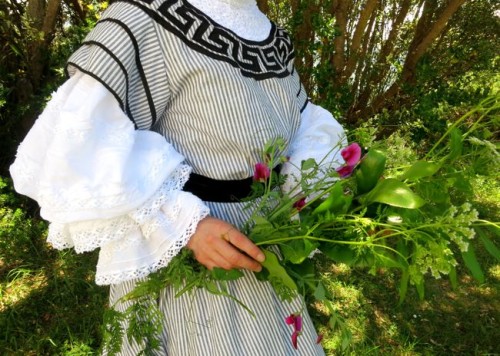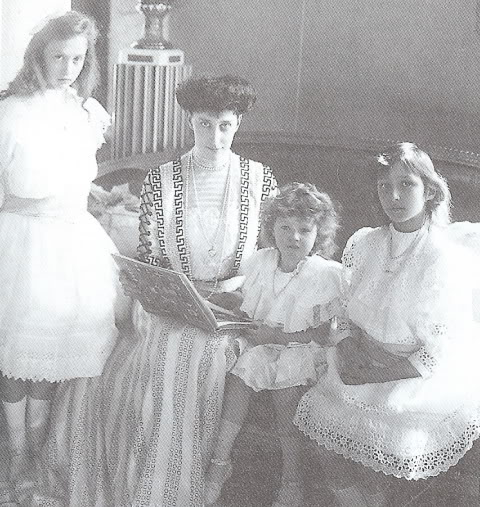I’m doing something a bit mad for the Historical Sew Fortnightly Challenge #24, in which you re-do one of the earlier challenges. My goal is to re-do ALL the challenges.
I know! Ambitious!
OK, I’m not making 23 separate items, but my goal is to make/finish a collection of items which together would qualify for every single one of the challenges so far.
To start with, here is the 1905 Greek Key Reception Dress, which covers 10 of the 23 challenges:
There is a wonderful story behind this dress.
The dress proper isn’t actually my work: it was patterned up by the wonderful Lynne (who frequently comments on my blog, and who gave me the fabulous fir sleeve for the Fur & Scales muff), and sewn by her equally wonderful friend Pamela for a production of the Importance of Being Ernest some years ago.
Being Lynne, she did a beautifully researched garment that was equally beautifully made – far more so than any theatre could hope for! The gown is a perfectly patterned version of the 1905-7 Afternoon Dress in Janet Arnold’s Patterns of Fashion. It was definitely the best costumed regional performance of IoBE ever staged. The few big concessions to theatre-wear were price (no budget) and washability. The dress is cotton and the sleeves and collar/yoke were done in synthetic lace, and the meander motifs at the hem were simply ironed on.
While perfect for stage costume, the sleeves and yoke were a bit worse for the wear from a few performances. The body of the dress, however, was in perfect condition. So I removed the sleeves and yoke and remade them in white cotton and cotton lace.
I also added some interior engineering to hold the dress in place (actresses may have to bend and move and get undressed quickly, but models don’t), re-stitched on all the hooks and bars which were coming loose, and re-did the sash in black velvet. Finally, I sewed down the meander trim around the hem, a process that I thought would be done in an hour and took me over 5!
Remaking the dress was a bit worrisome, as it isn’t even my size – it’s made for someone three inches shorter than me, and a size and a half smaller. So I had to guess on sizing throughout the construction process.
When it was finished I had to find someone to wear it, which was also a bit tricky. I’m lucky that dear A agreed to model for me – she’s even tinier than the dress is, so our photoshoot has an adorable sense of ‘teenage girl puts her hair up for the first time and borrows Mum’s party frock to feel elegant for an afternoon’ in some shots.
For the photoshoot, we went to the Massey Memorial, the burial site of William Massey, New Zealand Premier from 1912-1925. The Memorial is perched on an isolated hill on the Miramar Peninsula, overlooking Wellington Harbour.
When we set out it was the perfect day for a photoshoot: blue sky, but with cloud cover just over the sun, giving lovely bright, diffused light. And then the minute we arrived at the location the cloud blew away and we were left with stark, glaring sunshine reflecting off the white marble.
But we persevered, and got some lovely images out of less than ideal conditions.
I have slight reservations about the poof of the sleeves, but overall I’m thrilled that the dress is getting a second chance to be a star. It was such a beautiful garment when I received it, and now it’s got a new spin.
So what challenges does this frock cover?
#2: UFO – I meant to get this dress done for Challenge #18, but it wasn’t done in time, so it’s definitely a UFO.
#4: Embellish – The decorative details are really what make this garment: the Greek-Key motifs, and the lace trimming on the upper bodice and sleeves turn it into something fabulous and unique.
#6: Stripes – Black and white stripes = fantastic
#10: Literature – This one is a double – first, the dress was originally made for Gwendolyn in The Importance of Being Ernest. Plus, although 1900 is a bit late for Anne of Green Gables as a young girl (her children, after all, were old enough to go fight in WWI), the HUGE puffy sleeves of this frock were certainly an Anne moment for me. I was a bit astonished when they turned out to be so big based on Arnold’s pattern!
#12: Pretty Pretty Princesses – this dress is certainly very frilly and princess-y, but to make it even more apt, here is Princess Ingeborg of Denmark (another awesome princess) reading to her children in a Greek-key bedecked frock that is slightly reminiscent of this one.
#13: Lace and Lacing – Note the masses of lace on the guimpe and sleeves? Mission accomplished!
#15: Colour Challenge White – All the parts I had made are white!
#18: Re-make, Re-use & Re-fashion — The challenge which I originally started working on this dress for.
#19: Wood, Metal, Bone — OK, this one is a teeny bit of a push, but there are bones in the collar.
#23: Generosity & Gratitude — Thank you, thank you, THANK YOU Lynne for the amazing dress, with all the really hard stuff already done! I’m really excited to have ‘collaborated’ with you!
And obviously:
So, 10 challenges down, 13 more to go!
Fabric: 1m cotton lawn for the sleeves, scraps of cotton sateen for the yoke facing – all from stash, leftover from other projects
Pattern: 1905-7 Afternoon Dress from Janet Arnold’s Patterns of Fashion
Year: 1905-7
Notions: Thread (LOTS of it – I used up 3 spools of black on the meander border, and 1 of white on the sleeves and yoke), metres and metres of white cotton lace (stash – at the most I paid 60 cents a meter for it, but it was so long ago I can’t remember, which means it doesn’t count, right?).
How historically accurate is it? This one has me baffled on how to answer it. I un-did the theatre-friendly construction and re-did it to be fussy and historical, but while re-making is a very historical process, my actual techniques weren’t. Maybe 65%?
Hours to complete: 12. The lace of the yoke is narrow pieces sewn together, the hem applique took forever, the sleeves have pintucks…you get the picture!
First worn: As a re-make, Sunday 24 Nov for the photoshoot!
Total cost: $0 to me!










I am absolutely delighted to see this lovely dress living again!
One correction, though: I am not the person who sewed this dress. My friend, Pamela Edsall, was the maker. I gave her the pattern, the fabric, and the actress, and she did the rest. I shared this link with her, and talked to her on the phone about it, and she laughed (a laugh of shared suffering!) when we read the bit about the hem applique taking five hours. Oh, it does! She said the worst thing about placing the geometric pattern on the fabric was making the squares fit the curve. I can see that. The only time I have made much in the pattern, it was on a square piece, a relatively easy feat.
You mention your surprise at the size of the sleeves. They really have to be big and puffy to balance the large triple cap sleeve in the black and white fabric. You could even indulge in clear starching!
Thank you so much for all your tender loving care of our creation! You have made Pamela and me very happy!
You and Pamela are legends, and the people involved in the IoBE production were very lucky to have you working with them.
Thank you, Stella!
Oh thank you! For the dress, and the correction! It’s good to have the correct credit (though patterning is sometimes half the battle). I’m so pleased that you like it, and am honoured to be part of the frocks next act.
In the endless hours of sewing around the border I was EXTREMELY impressed by Pamela’s skills at making a straight pattern fit a curved border!
I half agree with you on the sleeves – when I picked fabric to re-make the sleeves in I specifically picked something with a bit of body, as the lace that they had originally been made with had gone flat in time, but they do seem to dominate the dress.
When I said I gave Pamela the pattern, I really should have said that I gave her the two photocopied pages from Janet Arnold. We each made up our own patterns – which is why, from the same pattern, I ended up with an over-bust corset while hers was under the bust. Like Chinese whispers, only with fabric.
Ah-hah! Funny how that happens!
Wow! Is it ever pretty!
Beautifully done! …I’m not typically a fan of puffy sleeves but those are so lovely that I want to find some dress to make them for now. (Random thought: could an upcoming challenge be “poof/puffy” to make something from any time period that has a definite puffy-ness to it?) That has to be the record for most challenges represented/completed in a single garment…!
It’s beautiful. I love meander patterns, and I have some planned for Challenge 26, although I still haven’t got my Challenge 23 photos up yet or started challenge 24… Sigh. I need to get my A into G. Anyways, back on topic: I’m well aware of the time meander patterns take to apply and whenever I see them I appreciate the time and effort that went into them.
I see what you mean about the sleeves, but I don’t think they are too big, and this is coming from someone who normally hates big poofy sleeves. This dress has a lot of personality and I think it can handle big sleeves just fine.
Absolutely gorgeous! Well done! I love that you made over a theatre costume. I have something in my to-do list for making over a movie costume, so this is really inspiring!